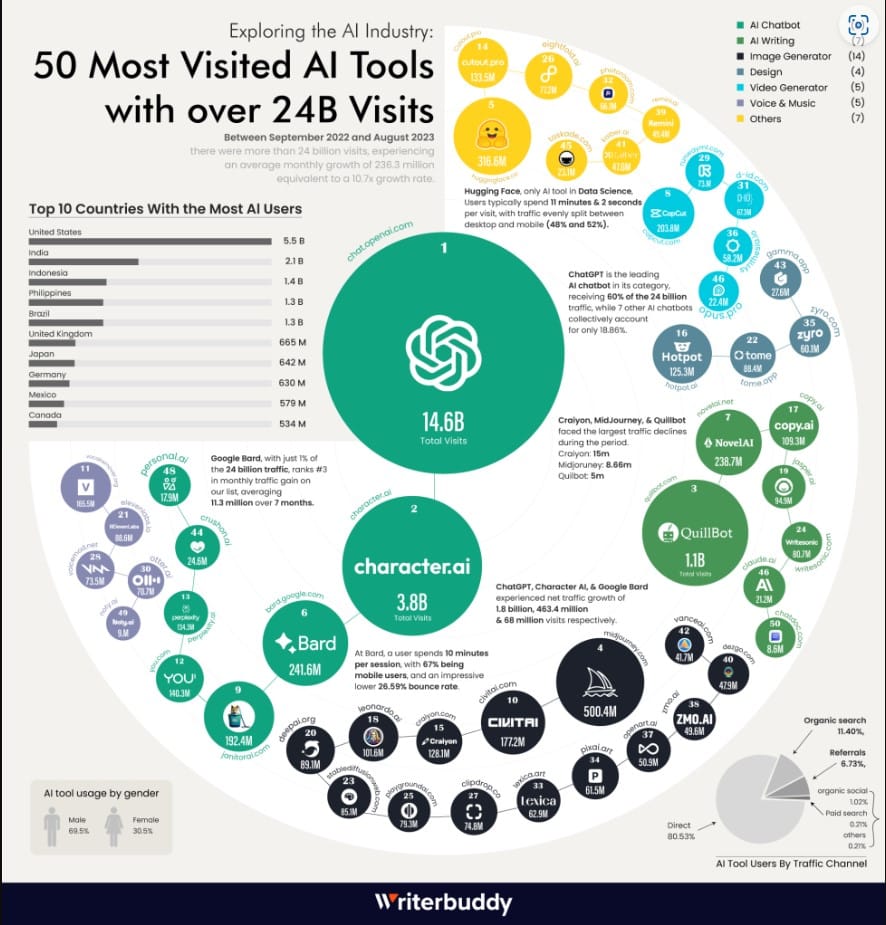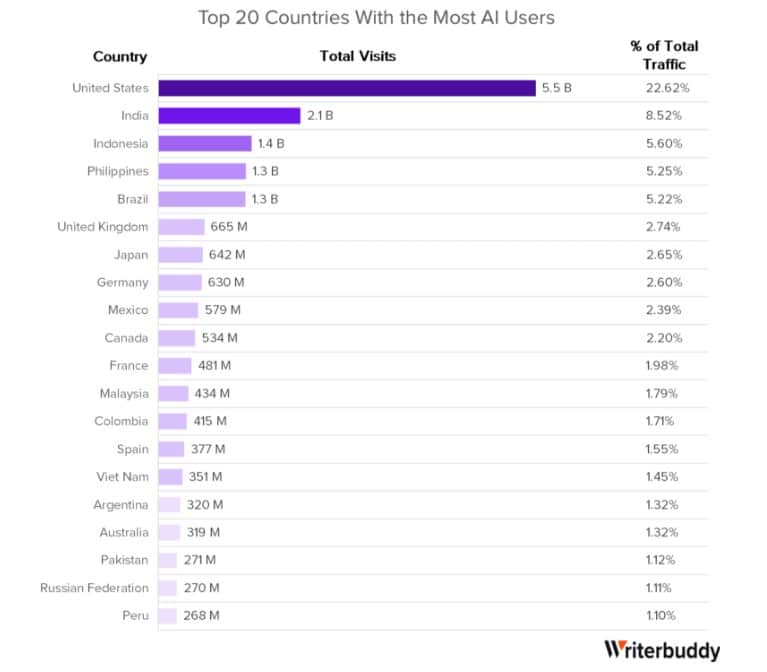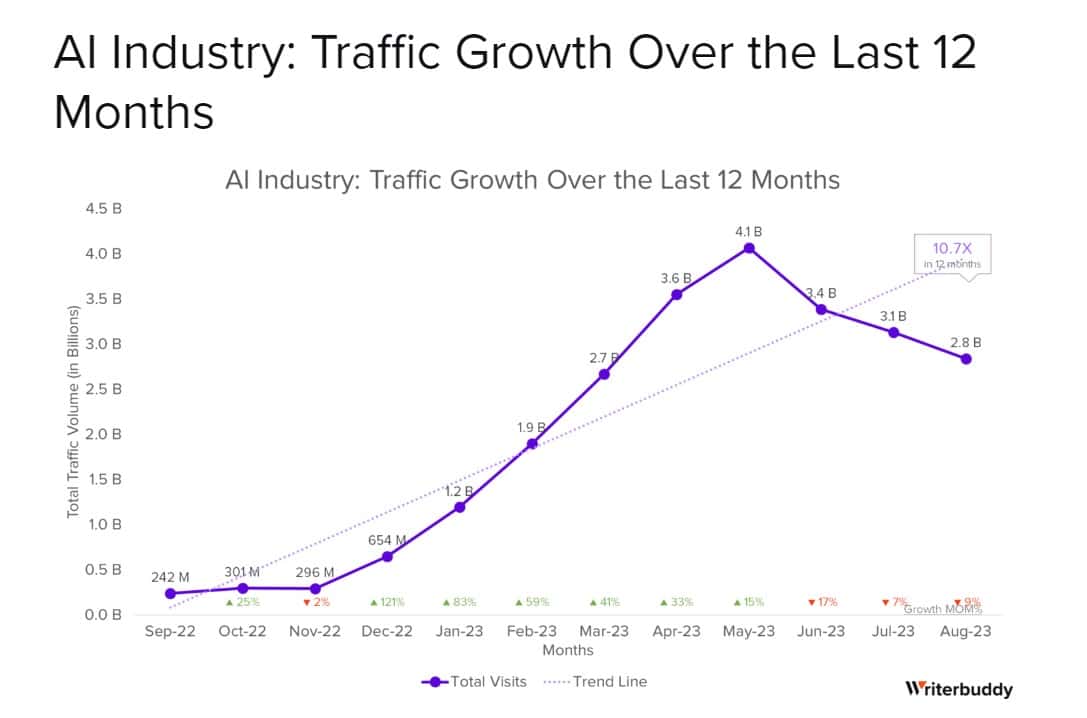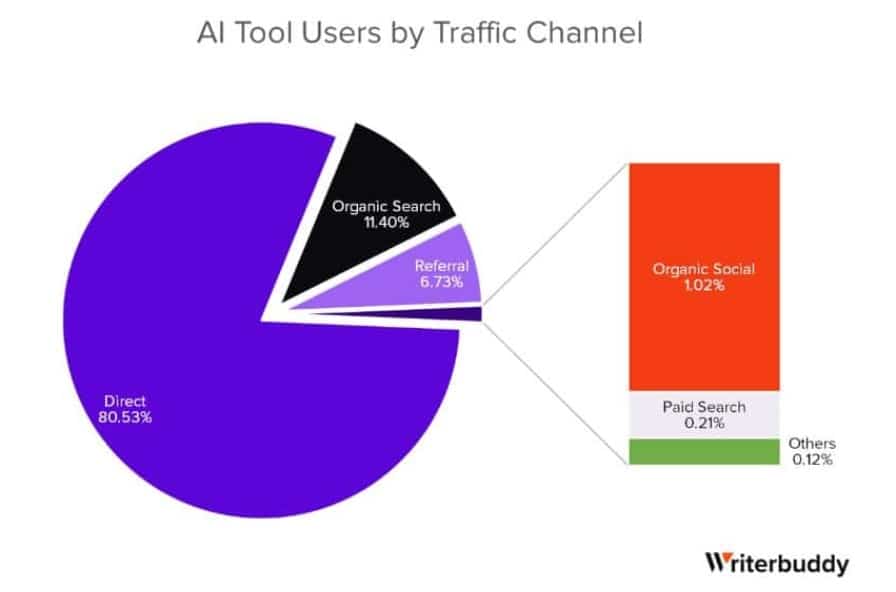It’s staggering to think about how profoundly the business world has changed in the last 12 months, since we were introduced to ChatGPT, the firebrand bot that started the revolution. In that time, business priorities, strategies and cultures have been upended around the world, on a path to uber-productivity that has us all wondering what generative AI has in store for us in the year ahead. Among consumers though, usage appears to have peaked in May and has been on a steady decline ever since. More on this below.
New analytical research from AI-content tool developer WriterBuddy lets us take a look back at a landmark year of AI activity among consumers, exploring the industry’s growth from September 2022 to August 2023 and covering over 3,000 AI tools. The numbers are astounding—the top 50 generative AI toolmakers amassed a total of 24 billion visits to their tool pages, and of course it was ChatGPT leading the pack with 14 billion visits to the OpenAI wunderkind alone, accounting for 60 percent of the total traffic.
The research, conducted by WriterBuddy data scientist and AI enthusiast Sujan Sarkar, offers an holistic view of the AI industry’s digital footprint, revealing that the top three tools—ChatGPT, Character AI, and Google Bard—saw net traffic growths of 1.8 billion, 463.4 million, and 68 million visits, respectively. Other tools, such as Craiyon, MidJourney, and Quillbot, didn’t have the same success, as each had significant traffic declines during the same period.

Key insights from the AI traffic analysis:
- 50 AI tools garnered 24 billion visits from Sep 2022 to Aug 2023
- ChatGPT captured 60 percent of the traffic with 14 billion visits
- Winners: ChatGPT, Character AI, Google Bard
- Losers: Craiyon, MidJourney, Quillbot
- AI industry grew 10.7x, averaging 236.3 million growth in visits monthly
- The US contributed 22.62 percent (5.5 billion visits), while Europe totaled 3.9 billion
- 69.5 percent male vs. 30.5 percent female user disparity in AI tools
- 63 percent accessed AI tools on mobile devices
The global AI landscape reveals interesting trends
The US, with its tech dominance, unsurprisingly leads in AI traffic at 5.5 billion visits, despite its smaller population. Following closely is tech-savvy India with 2.1 billion visits.
Meanwhile, countries like Indonesia, the Philippines, and Brazil hover around the 1.3 to 1.4 billion mark. Strikingly, China, with its vast populace, is not in the top 20—perhaps a nod to its native AI innovations and regulatory stance.
On the other hand, Europe, encompassing the robust tech hubs of the EU, lags behind, possibly wary of stringent AI regulations. This European caution isn’t new but has been a consistent narrative since 2008, with a hint of growing interest.

Is the AI bubble already bursting?
In the graph below, you see the remarkable rise of AI use, hitting a 4.1 billion visits peak in May, followed by a dropoff over the summer—amounting to a traffic loss of 1.2 billion across these tools, particularly ChatGPT.
This significant pullback on the surface might suggest that AI use has peaked and is now on the decline. The WriterBuddy study points to news reports such as this one on Yahoo Finance asking the question of whether the AI bubble is indeed popping. This seems very unlikely, but as of now seems to be the pattern.
But why? It’s unclear at the moment, although the new report offers some potential explanations, including imminent regulatory changes impacting usage, a temporary post-hype burnout phase, possible shifts in consumer preferences based on privacy and/or ethical concerns, and—more likely—the adoption of recently launched AI apps, which allow users to access the tools directly on their phones instead of through a web browser, and this would result in a decline in web traffic even though usage might remain high.

AI tool users by traffic channel
A vast 80.53 percent of AI tool users access them directly, indicating loyal or recurring users. Organic search follows at 11.40 percent, showcasing strong SEO practices. Referrals make up 6.73 percent, likely from partnerships or user recommendations. Despite AI’s prominence on social platforms, organic social accounts for a mere 1.02 percent, suggesting untapped potential. Both paid search and other channels have a negligible presence, hinting at minimal ad spend for these tools.

AI tool users by device
A commanding 63.20 percent of AI tool users access via mobile devices, emphasizing the need for mobile-responsive designs in the AI industry, potentially linked to Open AI’s app launches. On the flip side, desktop users represent 36.80 percent of users, signifying that, while traditional platforms remain relevant, the shift towards mobile is clear. This highlights the prevailing move to mobile in tech and the imperative for AI developers to focus on mobile adaptability.
AI tool use by gender
A significant gender gap exists in AI tool usage, with 69.5 percent male users and 30.5 percent female users. This disparity, possibly reflecting underlying discrepancies in tech roles, suggests a need for the industry to delve deeper into potential societal, educational, or promotional barriers causing this imbalance.
Writerbuddy used SEMrush, a reliable SEO tool, to collect data. They gathered info from AI tool directories and narrowed down to the most visited 50.








